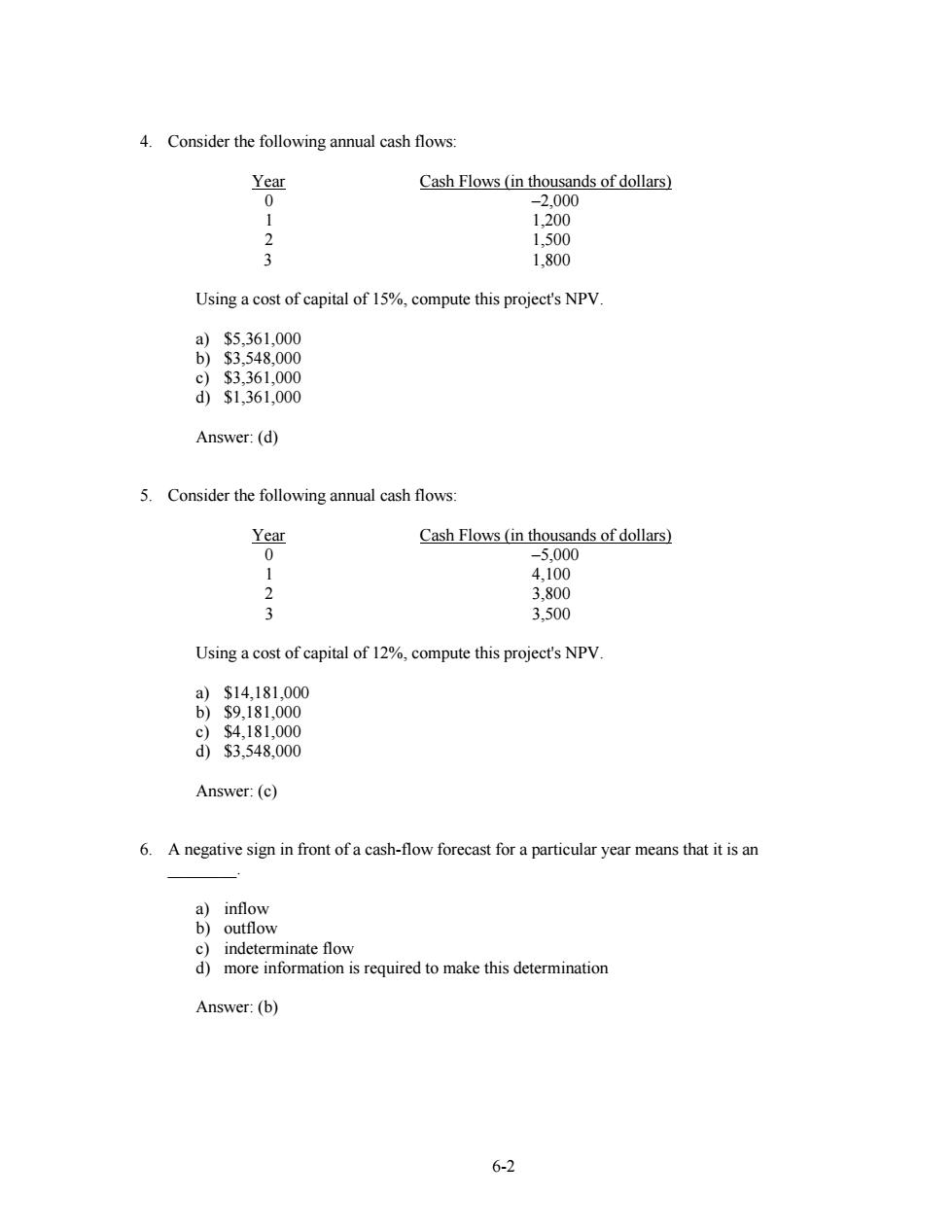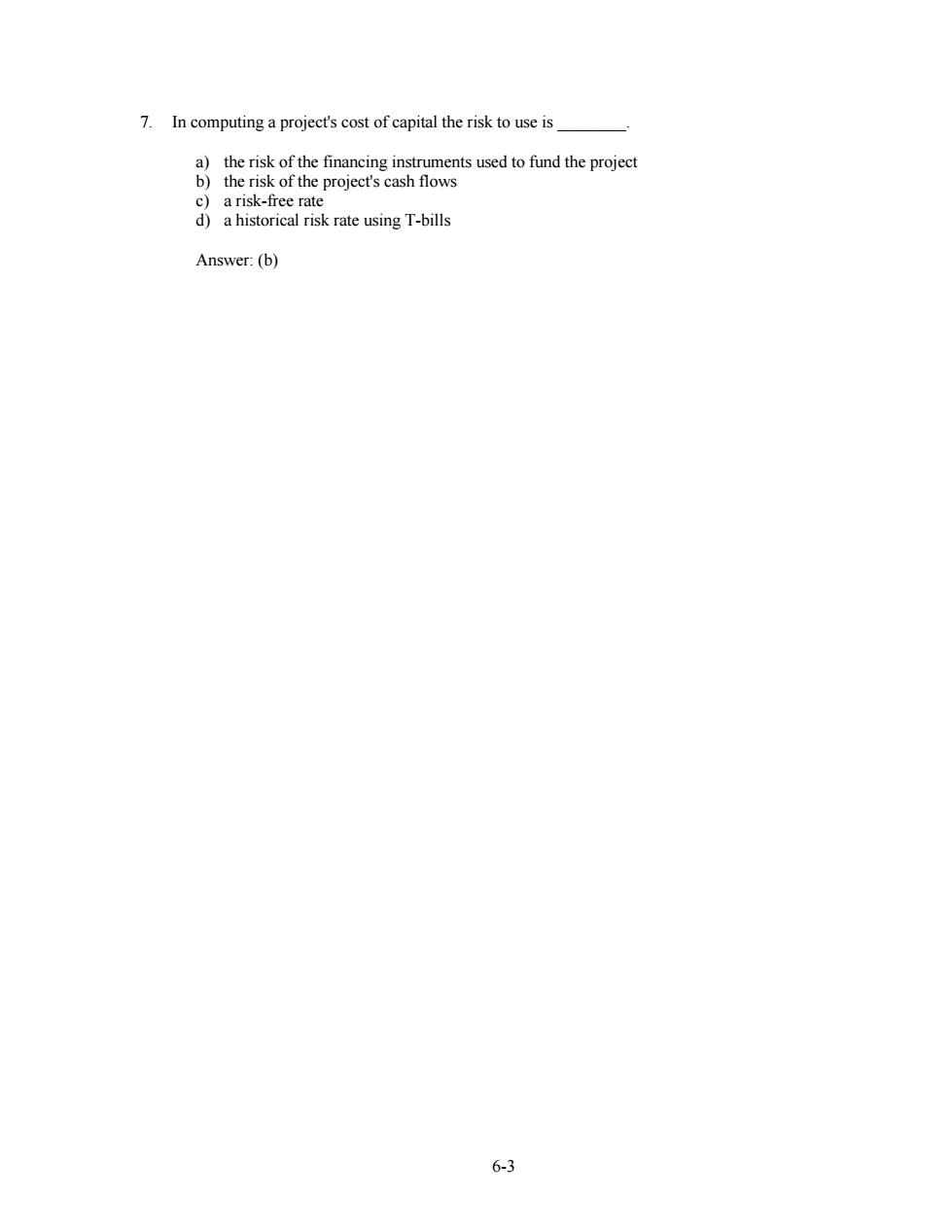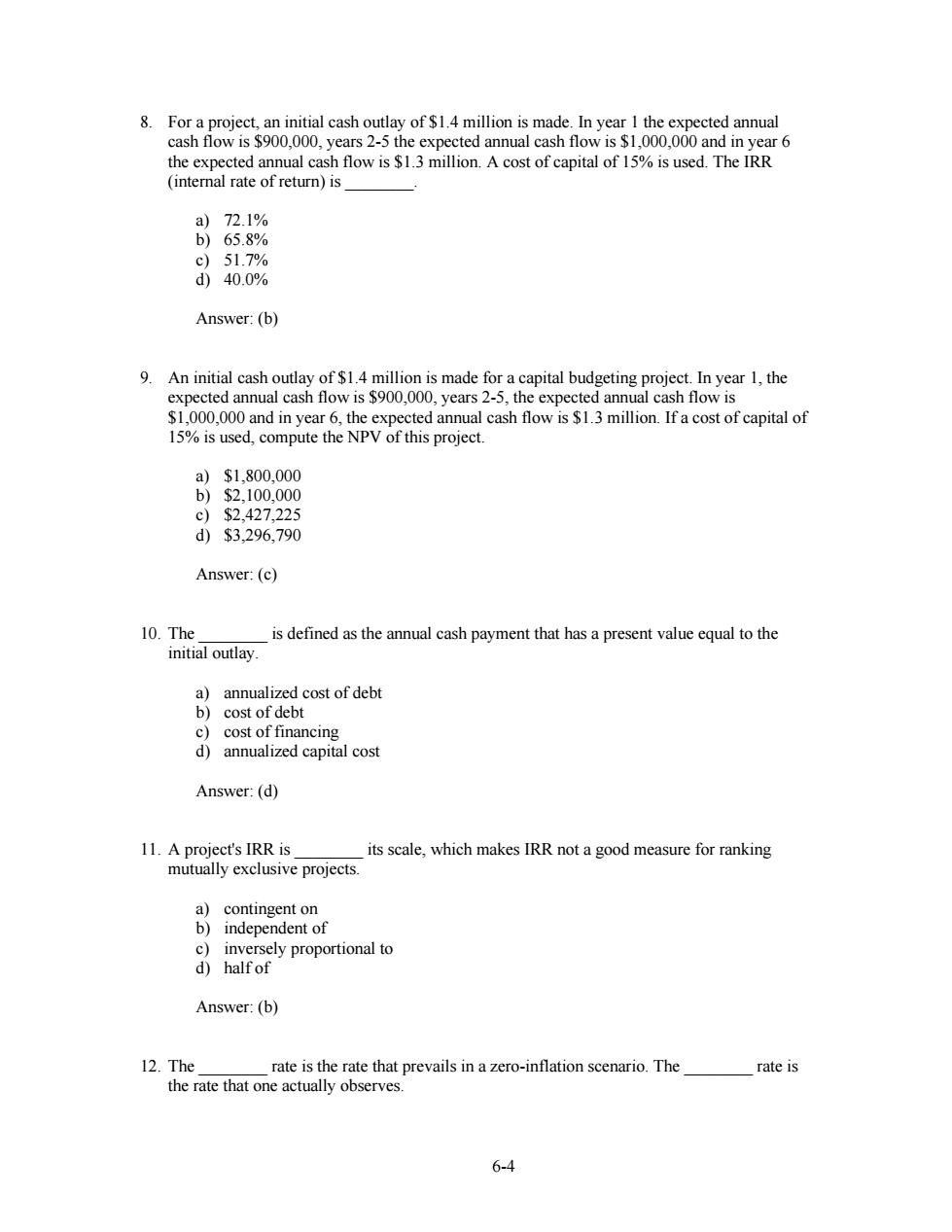
Chapter Six The Analysis of Investment Projects This chapter contains 41 multiple choice problems,20 short problems and 8 longer problems. Multiple Choice 1.The objective of a firm's management is to only undertake the projects that the market value of shareholders'equity. a)decrease b)do not decrease c)change d)do not change Answer:(b) 2.The decision rule that management uses with the net present value is to undertake only those projects with NPV. a)a discounted b)a contingent c)a positive d)negative Answer:(c) 3.The NPV of a project represents the amount by which it is expected to increase a)the break-even point b)capital budgeting c)capital expenditures d)shareholder wealth Answer:(d) 6-1
6-1 Chapter Six The Analysis of Investment Projects This chapter contains 41 multiple choice problems, 20 short problems and 8 longer problems. Multiple Choice 1. The objective of a firm's management is to only undertake the projects that ________ the market value of shareholders' equity. a) decrease b) do not decrease c) change d) do not change Answer: (b) 2. The decision rule that management uses with the net present value is to undertake only those projects with ________ NPV. a) a discounted b) a contingent c) a positive d) negative Answer: (c) 3. The NPV of a project represents the amount by which it is expected to increase ________. a) the break-even point b) capital budgeting c) capital expenditures d) shareholder wealth Answer: (d)

4.Consider the following annual cash flows: Cash Flows (in thousands of dollars) 0 -2,000 1,200 2 1,500 3 1,800 Using a cost of capital of 15%,compute this project's NPV. a)$5,361,000 b)$3,548,000 c)$3,361,000 d)$1,361,000 Answer:(d) 5.Consider the following annual cash flows: Year Cash Flows (in thousands of dollars) 0 -5,000 1 4,100 2 3,800 3 3,500 Using a cost of capital of 12%,compute this project's NPV. a)$14,181,000 b)$9,181,000 c)$4,181,000 d)$3.548.000 Answer:(c) 6.A negative sign in front of a cash-flow forecast for a particular year means that it is an a)inflow b)outflow c)indeterminate flow d)more information is required to make this determination Answer:(b) 6-2
6-2 4. Consider the following annual cash flows: Year Cash Flows (in thousands of dollars) 0 –2,000 1 1,200 2 1,500 3 1,800 Using a cost of capital of 15%, compute this project's NPV. a) $5,361,000 b) $3,548,000 c) $3,361,000 d) $1,361,000 Answer: (d) 5. Consider the following annual cash flows: Year Cash Flows (in thousands of dollars) 0 –5,000 1 4,100 2 3,800 3 3,500 Using a cost of capital of 12%, compute this project's NPV. a) $14,181,000 b) $9,181,000 c) $4,181,000 d) $3,548,000 Answer: (c) 6. A negative sign in front of a cash-flow forecast for a particular year means that it is an ________. a) inflow b) outflow c) indeterminate flow d) more information is required to make this determination Answer: (b)

7.In computing a project's cost of capital the risk to use is a)the risk of the financing instruments used to fund the project b)the risk of the project's cash flows c)a risk-free rate d)a historical risk rate using T-bills Answer:(b) 6-3
6-3 7. In computing a project's cost of capital the risk to use is ________. a) the risk of the financing instruments used to fund the project b) the risk of the project's cash flows c) a risk-free rate d) a historical risk rate using T-bills Answer: (b)

8.For a project,an initial cash outlay of $1.4 million is made.In year I the expected annual cash flow is $900,000,years 2-5 the expected annual cash flow is $1,000,000 and in year 6 the expected annual cash flow is $1.3 million.A cost of capital of 15%is used.The IRR (internal rate of return)is a)72.1% b)65.8% c)51.7% d)40.0% Answer:(b) 9.An initial cash outlay of $1.4 million is made for a capital budgeting project.In year 1,the expected annual cash flow is $900,000,years 2-5,the expected annual cash flow is $1,000,000 and in year 6,the expected annual cash flow is $1.3 million.If a cost of capital of 15%is used,compute the NPV of this project. a)$1,800,000 b)$2,100,000 c)$2,427,225 d$3,296,790 Answer:(c) 10.The is defined as the annual cash payment that has a present value equal to the initial outlay a)annualized cost of debt b)cost of debt c)cost of financing d)annualized capital cost Answer:(d) 11.A project's IRR is its scale,which makes IRR not a good measure for ranking mutually exclusive projects. a)contingent on b)independent of c)inversely proportional to d)half of Answer:(b) 12.The rate is the rate that prevails in a zero-inflation scenario.The rate is the rate that one actually observes. 6-4
6-4 8. For a project, an initial cash outlay of $1.4 million is made. In year 1 the expected annual cash flow is $900,000, years 2-5 the expected annual cash flow is $1,000,000 and in year 6 the expected annual cash flow is $1.3 million. A cost of capital of 15% is used. The IRR (internal rate of return) is ________. a) 72.1% b) 65.8% c) 51.7% d) 40.0% Answer: (b) 9. An initial cash outlay of $1.4 million is made for a capital budgeting project. In year 1, the expected annual cash flow is $900,000, years 2-5, the expected annual cash flow is $1,000,000 and in year 6, the expected annual cash flow is $1.3 million. If a cost of capital of 15% is used, compute the NPV of this project. a) $1,800,000 b) $2,100,000 c) $2,427,225 d) $3,296,790 Answer: (c) 10. The ________ is defined as the annual cash payment that has a present value equal to the initial outlay. a) annualized cost of debt b) cost of debt c) cost of financing d) annualized capital cost Answer: (d) 11. A project's IRR is ________ its scale, which makes IRR not a good measure for ranking mutually exclusive projects. a) contingent on b) independent of c) inversely proportional to d) half of Answer: (b) 12. The ________ rate is the rate that prevails in a zero-inflation scenario. The ________ rate is the rate that one actually observes

a)nominal,inflation b)real,expected c)nominal,real d)real,nominal Answer:(d) 6-5
6-5 a) nominal, inflation b) real, expected c) nominal, real d) real, nominal Answer: (d)